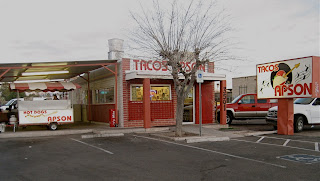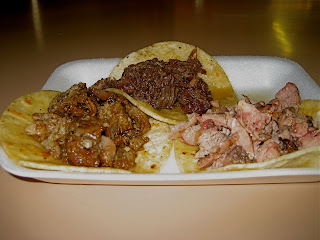It was tongue that opened my eyes to offal. About six years ago I saw it on the menu as tacos de lengua at my favorite restaurant in Gainesville, FL -- La Tienda. I didn't even know people ate tongues, but I knew that if La Tienda served it, then it was probably good. It was good. Really, really good. The tongue chunks were moist, tender, beefy and delicious. Bumpy (taste buds), bite-size chunks taken from what was obviously a giant cow's tongue sat atop three small corn tortillas with chopped onions, fresh cilantro, halved limes and salsa verde. The meat flavor reminded me of my mother's pot roast I'd grown up eating, but the texture was juicier and more tender. Whatever reservations I had about eating a part of an animal that was awkwardly familiar to my own body (given that I have my own tongue in my mouth), quickly disappeared. So did the tacos. It was a meal that I will never forget.
So when I saw a whole beef tongue being sold by the dairy folks at the farmer's market a few days later, I didn't pass it up. I wanted to recreate tacos de lengua in my own kitchen. I scrubbed it clean, boiled it, peeled it (more on this process later), chopped it, sauteed it with onions and served it with tomatillo salsa on warm tortillas. It was excellent, nearly as good as La Tienda's -- proof that tongue is forgiving. If you take the necessary time to prepare it, you are rewarded with great flavor and texture.
In Tucson tongue tacos are everywhere, from hole-in-the-wall taco bars to mobile stands dotted alongside many roads. And they are always good. The best ones though, like much of the food here, are on the south side.

Tacos de lengua at Birrieria Guadalajara
I recently ate lengua at Birrieria Guadalajara in South Tucson at the corner of 22nd street and 4th avenue. It's a brick-and-mortar taco bar that looks unchanged in fifty years. A Formica counter and a few bar stools separate the kitchen from the tiny dining room and a sliding-glass window opens from the side of the kitchen to a caged-in patio with more tables and chairs. The tacos come in orders of three and are all under $5. They are giant by taco standards -- the tortillas are the size of my face. They come with the usual fresh cilantro, onions and salsa, but are also topped with pickled radishes and carrots, which I'd never seen before. The tongue of course was delicious. Each bite was big and juicy, liquid-trailing-down-your-arm juicy. The acidity and spiciness of the toppings contrasted the mellow beefiness of the tongue.
Two blocks south of Birrieria Guadalajara on 4th avenue is American Meat Company, where last week I bought a fresh, 3lb beef tongue. I'd only eaten tongue on tacos and on tortas, but I guessed it would be good in just about anything. Like pho for example.
The broth for Vietnamese noodle soup, pho, is traditionally made from beef-marrow bones, the fatty, gelatin-rich leg bones. Tongue, with high-fat content and full-bodied flavor, is a perfect substitution. Every tongue recipe that I've seen begins by boiling or simmering it for two to three hours to cook it to melting tenderness. After that though, the cooking liquid is usually discarded and only the meat is served. In pho, however, the broth becomes just as important as the cooked meat.
After scrubbing it under running water, I put the whole tongue in a large pot with onions, green garlic, fresh ginger, fish sauce and spices (star anise, cloves, cinnamon, cardamom, coriander and fennel seeds). I covered it with water and simmered it for 2.5 hours.


While the tongue set aside to cool, I strained the broth and returned it to the pot on low heat. When the tongue was cool enough to touch I peeled off the thin, inedible layer of outer skin -- it comes off mostly in large strips -- and then chopped the meat into spoon-size pieces and put it in the serving bowls along with raw meatballs, fresh green garlic and cooked rice noodles.


The hot broth was ladled into the bowl (it cooks the meatballs) and topped with fresh cilantro, mint, diced serrano chiles, bean sprouts, a few squirts of Sriracha and hoisin sauce and fresh-squeezed lemon.

The assortment of flavors and textures in pho are amazing. The crispness of the bean sprouts contrast the tender, but chewy meat. The broth is rich and beefy, but also spicy from the Sriracha and chilies, sweet from the fish sauce and hoisin, and sour from the lemon. It's a meal eaten best with spoon in one hand (which should be abandoned for bowl-to-mouth drinking toward the end) and chopsticks in the other, and washed down with a cold, crisp beer. The more slurping the better. I don't know if anyone else has eaten tongue pho before, but I know they should now. It's delicious, every bit as good as the stuff made with marrow bones.
A more traditional preparation of tongue is as a cold-cut deli meat. The best Jewish delicatessens across the U.S. and western Europe are well stocked with smoked or cured tongue. It is sliced thin and served as a sandwich with mustard on rye bread. The only time I ate tongue deli-style was recently at Shlomo and Vito's in Tucson. Instead of mustard, chopped liver was spread on slices of rye, and in between was a heaping stack of smoked tongue. Smoking added flavor and color to the meat, but it was noticeably dryer than in other preparations. It was expensive too -- a half sandwich was $10, but came with fries and potato salad -- owed I'm sure to the fact that Shlomo and Vito's is one of only two delis that serve tongue in Tucson, and it's located in the most expensive area of town. I bet you can get more tongue for your money at a deli in New York or Chicago.













